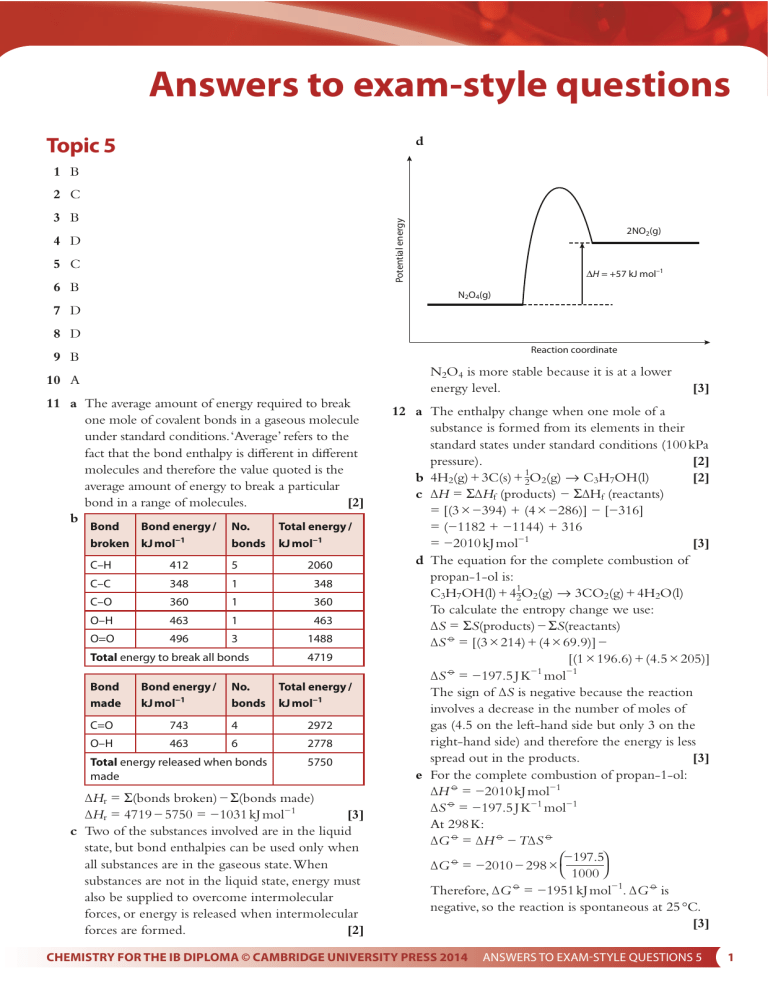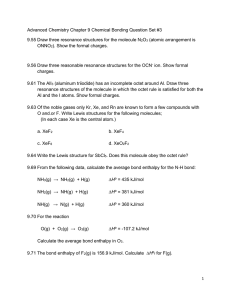
Answers to exam-style questions Topic 5 d 1 B 2 C Potential energy 3 B 4 D 5 C 6 B 2NO2(g) ∆H = +57 kJ mol–1 N2O4(g) 7 D 8 D Reaction coordinate 9 B N2O4 is more stable because it is at a lower energy level. 10 A 11 a The average amount of energy required to break one mole of covalent bonds in a gaseous molecule under standard conditions. ‘Average’ refers to the fact that the bond enthalpy is different in different molecules and therefore the value quoted is the average amount of energy to break a particular bond in a range of molecules. [2] b Bond Bond energy / broken kJ mol−1 No. bonds C–H 412 5 2060 C–C 348 1 348 C–O 360 1 360 O–H 463 1 463 O=O 496 3 1488 Total energy to break all bonds Bond made Bond energy / kJ mol−1 No. bonds Total energy / kJ mol−1 4719 Total energy / kJ mol−1 C=O 743 4 2972 O–H 463 6 2778 Total energy released when bonds made 5750 ∆Hr = Σ(bonds broken) − Σ(bonds made) [3] ∆Hr = 4719 − 5750 = −1031 kJ mol−1 c Two of the substances involved are in the liquid state, but bond enthalpies can be used only when all substances are in the gaseous state. When substances are not in the liquid state, energy must also be supplied to overcome intermolecular forces, or energy is released when intermolecular forces are formed. [2] [3] 12 a The enthalpy change when one mole of a substance is formed from its elements in their standard states under standard conditions (100 kPa pressure). [2] 1 [2] b 4H2(g) + 3C(s) + 2O2(g) → C3H7OH(l) c ∆H = Σ∆Hf (products) − Σ∆Hf (reactants) = [(3 × −394) + (4 × −286)] − [−316] = (−1182 + −1144) + 316 [3] = −2010 kJ mol−1 d The equation for the complete combustion of propan-1-ol is: C3H7OH(l) + 412O2(g) → 3CO2(g) + 4H2O(l) To calculate the entropy change we use: ∆S = ΣS(products) − ΣS(reactants) ∆S = [(3 × 214) + (4 × 69.9)] − [(1 × 196.6) + (4.5 × 205)] −1 −1 ∆S = −197.5 J K mol The sign of ∆S is negative because the reaction involves a decrease in the number of moles of gas (4.5 on the left-hand side but only 3 on the right-hand side) and therefore the energy is less spread out in the products. [3] e For the complete combustion of propan-1-ol: ∆H = −2010 kJ mol−1 ∆S = −197.5 J K−1 mol−1 At 298 K: ∆G = ∆H − T∆S ⎛−197.5⎞ ∆G = −2010 − 298 × ⎝ 1000 ⎠ Therefore, ∆G = −1951 kJ mol−1. ∆G is negative, so the reaction is spontaneous at 25 °C. [3] CHEMISTRY FOR THE IB DIPLOMA © CAMBRIDGE UNIVERSITY PRESS 2014 ANSWERS TO EXAMSTYLE QUESTIONS 5 1 [1] H H N N H H [2] Total energy / kJ mol−1 1st ionisation energy of K 418 kJ mol–1 K+(g) + Cl–(g) K(g) + 12 Cl2(g) 944 1 944 ∆Hat (K) 90 kJ mol–1 436 2 872 K(s) + 12 Cl2(g) Total energy / kJ mol−1 N–N 163 1 163 N–H 388 4 1552 Total energy released when bonds made 1715 ANSWERS TO EXAMSTYLE QUESTIONS 5 KCl(s) Hsol K+(aq)+ Cl –(aq) excess H2O 701 kJ mol–1 tt 14 a Lattice enthalpy is the enthalpy change when one mole of an ionic compound is broken apart into its constituent gaseous ions under standard conditions. [2] + − b i KCl(s) → K (g) + Cl (g) ii Cl(g) + e− → Cl−(g) [3] iii K(g) → K+(g) + e− The enthalpy change for the indirect route is the same as that for the direct route: ∆Hlatt = −(−436) + 90 + 418 + 121 − 364 [5] = 701 kJ mol−1 d Calcium chloride contains 2+ and 1− ions, whereas potassium chloride contains 1+ and 1− ions. The electrostatic attraction between more highly charged ions is greater, so there are stronger electrostatic attractions in the calcium chloride lattice and more energy is required to break the lattice apart. The Ca2+ ion is also smaller than the K+ ion, and this will also lead to the electrostatic attraction between the Ca2+ ion [2] and the Cl− ion being greater. e Using the lattice enthalpy from part c, a cycle can be constructed: H la ∆H = Σ(bonds broken) − Σ(bonds made) [3] ∆H = 1816 − 1715 = 101 kJ mol−1 d We have been given enthalpy change of formation data, so we can use the equation: ∆Hr = Σ∆Hf(products) − Σ∆Hf(reactants) The enthalpy change of formation of elements in their standard states is zero. Substituting known values we get: −622 = (2 × −286) − ∆Hf(N2H4(l)) Rearranging this we get: [3] ∆Hf(N2H4(l)) = 50 kJ mol−1 e We have calculated ∆Hf values in parts c and d and can use these in the equation: ∆H = Σ∆Hf (products) − Σ∆Hf (reactants) [2] ∆H = 101 − 50 = 51 kJ mol−1 KCl(s) yd No. bonds ∆Hlatt ∆Hf –436 kJ mol–1 Hh Bond energy / kJ mol−1 1816 indirect route No. bonds Total energy to break all bonds 2 1st electron affinity of Cl –364 kJ mol–1 K+(g) + e– + 12 Cl2(g) Bond Bond energy / broken kJ mol−1 Bond made K+(g) + e– + Cl(g) ∆Hat (Cl2) 121 kJ mol–1 b N2(g) + 2H2(g) → N2H4(g) c N= −N H–H c Enthalpy 13 a –340 kJ mol–1 –359 kJ mol–1 K+(g)+ Cl –(g) ∆Hsol = 701 − 340 − 359 = 2 kJ mol−1 [2] CHEMISTRY FOR THE IB DIPLOMA © CAMBRIDGE UNIVERSITY PRESS 2014


